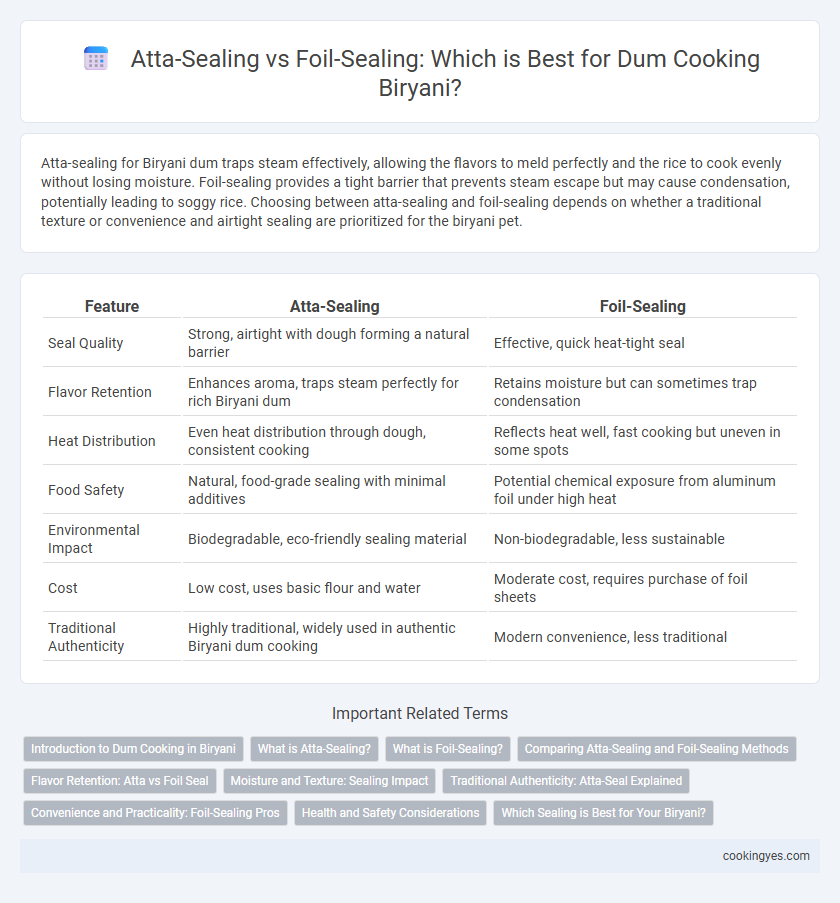Atta-sealing for Biryani dum traps steam effectively, allowing the flavors to meld perfectly and the rice to cook evenly without losing moisture. Foil-sealing provides a tight barrier that prevents steam escape but may cause condensation, potentially leading to soggy rice. Choosing between atta-sealing and foil-sealing depends on whether a traditional texture or convenience and airtight sealing are prioritized for the biryani pet.
Table of Comparison
| Feature | Atta-Sealing | Foil-Sealing |
|---|---|---|
| Seal Quality | Strong, airtight with dough forming a natural barrier | Effective, quick heat-tight seal |
| Flavor Retention | Enhances aroma, traps steam perfectly for rich Biryani dum | Retains moisture but can sometimes trap condensation |
| Heat Distribution | Even heat distribution through dough, consistent cooking | Reflects heat well, fast cooking but uneven in some spots |
| Food Safety | Natural, food-grade sealing with minimal additives | Potential chemical exposure from aluminum foil under high heat |
| Environmental Impact | Biodegradable, eco-friendly sealing material | Non-biodegradable, less sustainable |
| Cost | Low cost, uses basic flour and water | Moderate cost, requires purchase of foil sheets |
| Traditional Authenticity | Highly traditional, widely used in authentic Biryani dum cooking | Modern convenience, less traditional |
Introduction to Dum Cooking in Biryani
Dum cooking in biryani involves slow steaming meat and rice together, allowing flavors to meld deeply while retaining moisture. Atta-sealing uses a dough made from whole wheat flour to create an airtight seal on the pot, enhancing the infusion of spices and preventing steam from escaping. Foil-sealing, on the other hand, provides a quick, convenient seal but may not trap the flavors as effectively as the traditional atta-sealing method.
What is Atta-Sealing?
Atta-sealing involves using a dough made from wheat flour (atta) to seal the pot lid tightly during the dum cooking process of Biryani, creating a natural airtight environment that traps steam and enhances flavor infusion. This traditional method ensures slow cooking at low heat, allowing the rice and meat to absorb spices deeply while maintaining moisture. Compared to foil-sealing, atta-sealing provides better insulation, preventing steam from escaping and contributing to a richer, more aromatic Biryani.
What is Foil-Sealing?
Foil-sealing involves covering the biryani pot with aluminum foil before placing the lid, creating an airtight environment that traps steam and enhances the dum cooking process. This method ensures even heat distribution and prevents moisture from escaping, resulting in tender, flavorful rice and perfectly cooked meat. Foil-sealing is preferred for maintaining intense aromas and traditional taste in biryani by preserving the essence of spices during slow cooking.
Comparing Atta-Sealing and Foil-Sealing Methods
Atta-sealing involves using dough to create an airtight seal on the biryani pot, enhancing the slow-cooking process by trapping steam and intensifying flavors, resulting in a rich, aromatic dish. Foil-sealing employs aluminum foil to cover the vessel, offering a convenient, heat-resistant barrier that retains moisture but may allow minor steam leakage compared to atta-sealing. Culinary experts often prefer atta-sealing for traditional biryani dum cooking due to its natural airtightness and ability to infuse deeper taste profiles.
Flavor Retention: Atta vs Foil Seal
Atta-sealing in biryani dum cooking enhances flavor retention by allowing steam to circulate while trapping aromatic oils, resulting in a richer and more infused taste profile compared to foil sealing. Foil sealing, though effective at preventing moisture loss, often creates a steam-heavy environment that can dilute spices and reduce the intensity of the biryani's signature flavors. Choosing atta-sealing optimizes the sealing process for maximum flavor infusion and authentic aroma preservation during slow cooking.
Moisture and Texture: Sealing Impact
Atta-sealing retains moisture in biryani by allowing slight ventilation, preventing excessive condensation and ensuring a balanced texture with fluffy rice and tender meat. Foil-sealing traps steam more tightly, intensifying moisture retention but sometimes causing a softer, almost soggy texture in the final dish. Choosing atta-sealing promotes a drier, more aerated biryani texture, while foil-sealing favors enhanced juiciness and tenderness through increased steam concentration.
Traditional Authenticity: Atta-Seal Explained
Atta-sealing preserves the traditional authenticity of biryani by encapsulating the pot with a dough made from refined wheat flour, which traps steam and flavors effectively during the dum cooking process. This natural sealing method ensures even heat distribution and moisture retention, enhancing the delicate aroma and taste characteristic of authentic biryani. Unlike foil-sealing, atta-sealing prevents condensation from dripping back into the biryani, maintaining the perfect texture of rice and meat.
Convenience and Practicality: Foil-Sealing Pros
Foil-sealing offers superior convenience and practicality for Biryani dum cooking due to its airtight seal that effectively traps steam, ensuring perfect moisture and flavor retention. It is lightweight, disposable, and allows easy monitoring without disturbing the cooking process, making it ideal for both home cooks and commercial kitchens. Compared to atta-sealing, foil reduces preparation time and cleanup, enhancing overall efficiency.
Health and Safety Considerations
Atta-sealing in biryani dum cooking offers a natural, breathable barrier that minimizes moisture loss and prevents steam burns, enhancing safety by reducing pressure buildup. Foil-sealing, while effective in retaining moisture and heat, poses risks of metal contamination and can cause burns if handled improperly due to its high thermal conductivity. Choosing atta-sealing promotes healthier cooking by avoiding potential chemical leaching and ensuring safer handling during the slow-cooking process.
Which Sealing is Best for Your Biryani?
Atta-sealing preserves the authentic aroma and enhances the flavor by allowing slow steam release, maintaining moisture balance in biryani dum cooking. Foil-sealing offers a tighter seal that traps steam efficiently, ensuring even cooking but may sometimes cause excess condensation, impacting texture. Choosing the best sealing depends on desired moisture control and aroma retention for an ideal biryani experience.
Atta-sealing vs Foil-sealing for Biryani dum Infographic

 cookingyes.com
cookingyes.com